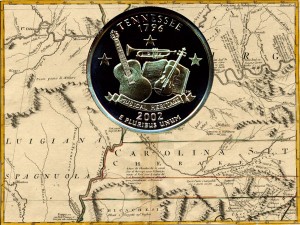Today, the Tennessee State Quarter Coin tells the story of North Carolina’s claim to the territory and their cession of that claim on February 25, 1790.
Two men, senators from North Carolina, presented to the Senate the cession:
“Now therefore know ye, That: we, Samuel Johnston and Benjamin Hawkins, senators aforesaid, by virtue of the power and authority committed to us by the said act, and in the name, and for and on behalf of the said state, do, by these presents, convey, assign, transfer, and set over unto the United States of America, for the benefit of the said states, North Carolina inclusive, all right, title, and claim which the said state hath to the sovereignty and territory of the lands situated within the chartered limits of the said state, as bounded and described in the above recited act of the General Assembly, to and for the uses and purposes, and on the condition’s mentioned in the said act. In witness whereof, we have hereunto subscribed our names, and affixed our seals, in the senate-chamber, at New York, this twenty-fifth day of February, in the year of our Lord, one thousand seven hundred and ninety, and in the fourteenth year of the independence of the United States of America.”
After the Revolutionary War, North Carolina claimed a large expanse. The cession of the “Southwestern Territory” did not happen easily or quickly.
From the Magazine of Western History published in 1887:
=====
In 1788 the state of North Carolina, in convention assembled, refused to ratify the Constitution of the United States. Upon further considering it again, in 1789, that state gave its assent to its adoption.
At this date, the state claimed and exercised jurisdiction from the Atlantic coast to the Mississippi river. Meanwhile settlements had been established on the Holston River, also on the Cumberland River, at and in the vicinity of Nashville, which was founded in 1784, and probably also about this time in the valley of the Tennessee River below Knoxville, which was laid out in 1789.
The state of North Carolina established two judicial districts for the convenience of these remote settlements, that for the Holston settlers being called Washington district, and the other the Cumberland district.
But the people wished to form a new government, one altogether independent of North Carolina, and with a view of furthering that purpose, those residing in the Washington judicial district held an informal convention at Jonesborough, and declared their independence of North Carolina.
They also organized the ” State of Frankland,” appointed a corps of executive and judicial officers, also elected a delegate to congress; but the whole performance being irregular, revolutionary, farcical, and congress declining to recognize Cocke, the delegate, the whole matter fell to the ground and the “state of Frankland ” was squelched out, although further and vigorous attempts were made to give force and effect to Frankland’s laws, and to determinedly force the collection of the taxes levied by the legislature of the pseudo-embryotic, revolutionary ” state of Frankland.”
Colonel John Sevier assumed to exercise the functions of governor of Frankland, and a revolutionist named Cocke was Frankland’s congressional delegate. North Carolina’s legislature passed an act of outlawry and attainder, dispersed the usurpers and their followers, and came off victorious.
Frankland was no more!
It was not long, however, until the act of outlawry and attainder was repealed, and Sevier and Cocke came soon to be honored names again in the Holston, the Cumberland and Tennessee valleys. Colonel John Sevier was elected governor of Tennessee in 1796, and Delegate Cocke became a member of the state legislature and of congress by the suffrages of the people of the state of Tennessee.
In 1790, the state of North Carolina ceded to the Federal government all that portion of its territory that now constitutes the state of Tennessee. The ceded country was erected into a territory of the United States, by an act of congress dated May 20, 1790, and was called “the Southwestern Territory.”
The ordinance of July 13, 1787, for the government of the “territory north west of the river Ohio,” with the exception of the sixth article, prohibiting slavery, was adopted as the fundamental law in its organization.
Hon. William Blount was appointed governor of the new territory in 1790, and continued to serve in that capacity until the sixth of June, 1796, on which day the congress of the United States admitted the state of Tennessee into the Union, and by that act put an end to the government of the “Southwest Territory.”
Colonel John Sevier, of Frankland fame, was Tennessee’s first governor, serving from 1796 until 1801, and again from 1803 to 1809.
=====
The Tennessee State Quarter Coin shows against a map of the Tennessee portion of North Carolina, circa 1785.
